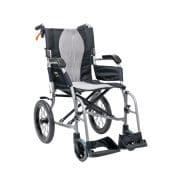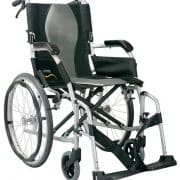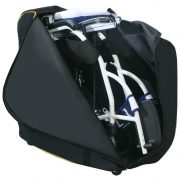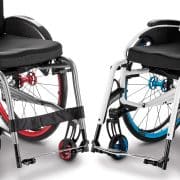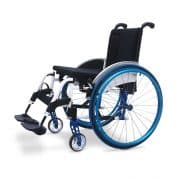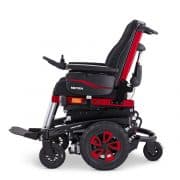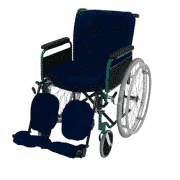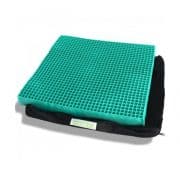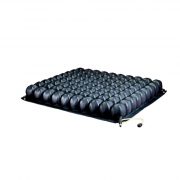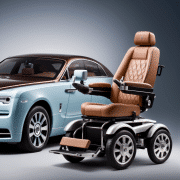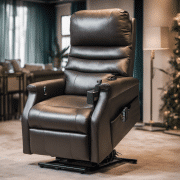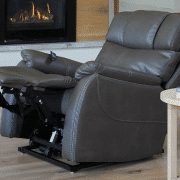Ultimate Guide to Buying a Wheelchair
Mobility devices, particularly wheelchairs, play an indispensable role in the daily lives of individuals with mobility impairments. These essential aids not only grant access to various services but also significantly enhance the overall quality of life. However, finding the right wheelchair requires careful consideration of multiple factors. In this comprehensive guide, we will explore the...

Mobility devices, particularly wheelchairs, play an indispensable role in the daily lives of individuals with mobility impairments. These essential aids not only grant access to various services but also significantly enhance the overall quality of life. However, finding the right wheelchair requires careful consideration of multiple factors. In this comprehensive guide, we will explore the different types of wheelchairs available and the key considerations to help you make an informed decision.
You might also be interested in Top Accessible Beaches in Australia for Wheelchair Users; Buying the Best Folding Wheelchair for You; 5 Most Important Things to Consider When Buying an Electric Wheelchair; Which is the Better Choice: Mobility Scooters or Electric Wheelchairs?; Wheelchair Parts: Parts of a Wheelchair You May Need To Replace
Is a wheelchair the suitable choice for your needs?
Wheelchairs offer an invaluable sense of freedom for individuals facing mobility limitations due to disabilities or health conditions, whether those limitations are temporary or more enduring. However, the decision to embrace a wheelchair ultimately hinges on personal or familial considerations. By carefully weighing up the considerations and factors in this guide, you can make an informed decision when choosing a wheelchair that aligns with your specific needs and lifestyle, ultimately enhancing your mobility and overall quality of life.
Getting Started
Embarking on the journey to select the perfect wheelchair involves several important considerations. Here’s where to begin:
Consult with Healthcare Professionals: It’s often a prerequisite for insurance coverage, especially when considering power wheelchairs, to obtain a prescription from a healthcare professional. Start by engaging in a conversation with your occupational therapist. They can assess your specific requirements and abilities, and recommend the most suitable mobility aids to help you either regain or maintain your independence.
Assess Additional Assistance Needs: When purchasing a wheelchair for a family member, it’s crucial to assess whether they require additional assistance for mobility. For instance, individuals with limited mobility or dementia may need full-time assistance to move around. In such cases, a transit wheelchair could be the most appropriate choice.
Freedom and Mobility: If your goal is to enhance personal freedom or alleviate walking-related symptoms, a self-propelled wheelchair might be the answer. However, keep in mind that these wheelchairs necessitate some upper body strength to operate, and they can be challenging to control on slopes and rough terrain.
Consider a Power Wheelchair: For the optimal combination of convenience and ease of use, consider an electric wheelchair. Operated through hand control, these wheelchairs are designed to fit into the same space as manual wheelchairs. They offer indoor and outdoor versatility for individuals with varying levels of strength and dexterity. They also excel at navigating ramps and slopes without causing fatigue. Plus, their comfortable seats allow for extended use without discomfort.
Intended Use: Reflect on how you intend to use the wheelchair. Will it be used infrequently or in conjunction with other mobility aids? Will you be maneuvering it both indoors and outdoors, including navigating small slopes and ramps? Assess your upper body strength if you plan to propel a manual wheelchair.
Consider Caregiver Assistance: If you have a caregiver to assist with mobility, take into account whether they can comfortably push the wheelchair. This consideration should factor in the chair’s weight and any slopes that may need to be negotiated.
Versatility of Wheelchairs
Most wheelchairs are thoughtfully engineered to navigate through compact, confined spaces, making them exceptionally suited for home use. On the other hand, sturdier models are tailored for outdoor adventures, capable of conquering challenging terrains such as pavements and slopes.
It’s worth noting that wheelchairs can seamlessly complement other mobility aids or transportation options. Take, for instance, folding wheelchairs—a lightweight, compact solution that conveniently fits into a car’s trunk, rendering them ideal for travel or instances where a larger mobility aid may prove unwieldy.
Furthermore, wheelchairs can serve as temporary aids during recovery from injuries or surgeries. This temporary assistance enables individuals to maintain their independence while sidestepping the risks of overexertion or hindering the recovery process due to excessive physical strain.
Factors to Consider Before Buying a Wheelchair
When it comes to choosing the perfect wheelchair, your top priority should be your mobility requirements and your personal preferences for comfort. Testing out various wheelchairs to assess your comfort levels before making a final decision is essential. Be sure to pay special attention to factors such as cushioning, backrest support, and ergonomic features to ensure an optimal seating experience.
Moreover, it’s crucial to make sure that the wheelchair’s seat width and depth are just right to prevent any discomfort. The availability of adjustable features should be a high priority, as they allow for a customised fit that caters to your specific needs. If you anticipate frequent wheelchair transport, keep portability in mind as a key consideration. Don’t forget to factor in the primary location where the wheelchair will be used most often, as this should align with your lifestyle and mobility requirements.
Let’s delve into the crucial factors to weigh when selecting the perfect wheelchair for your needs:
Indoor Use: If your primary domain of mobility is indoors, prioritise a wheelchair with exceptional maneuverability in tight spaces.
Outdoor Use: For those who require outdoor mobility, opt for models equipped with larger wheels and robust frames designed to tackle uneven terrain with ease.
Body Size and Weight: It’s essential to ensure that the chosen wheelchair can comfortably accommodate the user’s size and weight, providing both safety and comfort.
Backrests: A supportive backrest is paramount; explore options like an adjustable recline for enhanced comfort tailored to your liking.
Seat Cushions: Preventing pressure injuries and ensuring proper pressure distribution is key. Gel, foam, and air cushions are popular choices for optimal seating comfort.
Mobility Features: Consider whether a manual wheelchair, a power wheelchair, or a transport chair best suits your mobility requirements and preferences.
Footrests: Adjustable footrests can significantly improve comfort and posture during extended periods of sitting in the wheelchair.
Armrests: Look for wheelchairs with adjustable armrests, allowing flexibility and accommodating various arm positions for maximum comfort.
Leg Rests: Elevating leg rests or swing-away leg rests offer added flexibility and vital support for the legs.
Seat Height: Adjustable seat height is a practical feature that facilitates transfers and adapts the wheelchair to different activities seamlessly.
Lightweight Models: If maneuverability and transport are priorities, consider lightweight wheelchairs that are easier to handle and transport.
Foldability: For those on the go or with limited storage space, folding wheelchairs offer compactness and convenience, ideal for travel or storage.
Transport Chairs: These ultra-portable models are designed for occasional use and effortless transport, catering to those who need mobility aid flexibility.
Budget: Determine your budget, as wheelchairs span various price ranges. Extensive research and exploring financing options or insurance coverage can help you find an affordable solution that meets your needs.
Exploring the World of Wheelchairs
Wheelchairs offer a spectrum of options to cater to diverse mobility needs. Let’s delve into the different types:
Transit or Attendant-Propelled Wheelchairs: As the name suggests, these are designed to be pushed or propelled by a caregiver or attendant rather than the user. These wheelchairs typically have smaller rear wheels and are intended for situations where the user may require assistance with mobility.
Self-Propelled Wheelchairs: These empower users with independence and flexibility. They feature large rear wheels with hand rims, allowing the user to manually propel and control the wheelchair’s movement without assistance from a caregiver or attendant.
Travel Wheelchairs: These are lightweight and portable wheelchairs designed for easy transport and convenience during trips or outings. These wheelchairs are typically foldable and compact, making them suitable for travel by car, plane, or other means of transportation.
Power Wheelchairs: Also known as electric wheelchairs, these offer the pinnacle of independence and convenience. With a lever on the armrest to control speed and direction, they effortlessly navigate slopes and tight spaces, both indoors and outdoors. Power wheelchairs typically reach a maximum speed of around 5km/h, akin to a walking pace, and are more maneuverable than mobility scooters.
Complex Wheelchair Solutions: Tailored for individuals with intricate mobility challenges resulting from conditions like traumatic injury, neuromuscular diseases, or birth disorders, these bespoke solutions provide unparalleled comfort and independence. Qualified professionals, such as physiotherapists, occupational therapists, rehab engineers, and field technicians, collaborate to create a custom wheelchair frame and accessory combination that optimises seating and positioning for the user.
Sports Wheelchairs: Engineered for specific sports and recreational activities, these wheelchairs enhance performance and stability. Whether it’s basketball or tennis, sports wheelchairs are meticulously adapted to cater to the unique demands of each sport, offering agility and precision.
Paediatric Wheelchairs: Scaled down to accommodate children with mobility challenges, these specialised mobility devices prioritise pediatric users’ unique needs and proportions. They come in various styles and configurations, ensuring comfort, support, and maneuverability tailored to children’s age and mobility levels.
Bariatric Wheelchairs: Designed to accommodate individuals with higher body weights and sizes, these sturdy models boast reinforced frames and components to provide the necessary strength and support. With wider seats and higher weight capacities compared to standard wheelchairs, they ensure the comfort and safety of individuals facing weight-related mobility challenges.
Standing Wheelchairs: Innovative mobility devices that facilitate transitions from sitting to standing positions, offering a range of physical and psychological benefits. Powered mechanisms elevate users, promoting better circulation, improved bone density, and enhanced interaction with their environment. These wheelchairs, by bringing users to eye level with others, boost self-esteem and social engagement while enabling activities that require a standing position.
Choosing the Right Wheelchair Size
Selecting the right wheelchair size is crucial for comfort, especially during extended use. Here’s how to ensure a proper fit:
Weight Capacity: Be mindful of the maximum support weight listed for wheelchairs, as they vary. Ensure that the chosen wheelchair can safely accommodate your weight.
Seat Dimensions: A comfortable seat is essential. As a general guideline, there should be a 2-4 cm gap between the chair’s edge and your hips. This gap provides optimal comfort, approximately equivalent to the width of two fingers on either side.
Leg Position: When seated in the wheelchair, your hips and knees should ideally form right angles or approximately 90-degree angles. If you anticipate spending prolonged periods in your wheelchair, consider one that offers adjustments to accommodate various tasks and needs. Also, ensure that the footplate is at an appropriate height, especially if you plan to use the wheelchair outdoors on uneven surfaces.
Enhancing Your Wheelchair Experience with Accessories
To make your wheelchair usage safer and more comfortable, consider these essential accessories:
Household Adaptations: Evaluate your home for necessary modifications that enable safe and convenient wheelchair use, both indoors and outdoors.
Basic Cushions: Basic cushions add extra padding to your wheelchair seat for improved comfort during extended periods of use.
Pressure Cushions: Enhance your seating comfort with pressure cushions that provide support and reduce the risk of pressure injuries.
Back Supports: Back supports offer additional lumbar support and comfort for extended wheelchair sessions.
Small Ramps: Install small ramps to navigate doorsteps and minor steps within your home. Opt for ramps with rubber or textured surfaces to prevent slips or slides.
Portable Ramps: Invest in portable ramps that you can take with you when needed, such as when traveling or going on holiday. These ramps offer versatility and accessibility wherever you go.
Power Assist Device: This convenient device attaches directly to your wheelchair, providing enhanced mobility and reducing the need for strenuous physical effort. It offers a smoother and more comfortable wheelchair experience.
Considerations for Wheelchair Owners
Once your wheelchair is at home, it’s essential to make the necessary adjustments to ensure both comfort and functionality.
Power Wheelchairs: If you’re using an electric wheelchair, acquaint yourself with the controls. Practice maneuvering on a clear, level surface. This will help you become confident in moving forward, turning, and reversing.
Storage: Consider where you’ll store your wheelchair when it’s not in use. If you have an electric wheelchair, ensure convenient access to a power outlet for charging between uses.
Insurance: Protect your investment by securing insurance coverage against potential damage, theft, or loss. Some home and contents insurance policies may cover your wheelchair, but be aware that not all extend to use outside your home. Additional premiums may apply. If needed, explore separate wheelchair insurance policies that comprehensively cover theft, damage to your wheelchair.
Maintenance: Regular servicing is vital to keep your wheelchair in optimal condition. Electric wheelchairs typically require annual servicing, while manual wheelchairs should be serviced in line with their usage.
Adjustments: Take the time to tailor your wheelchair to your needs. This might involve raising or lowering the seat’s height, tweaking the wheel angles, and positioning the footplate to maximise comfort. Ensure you’re familiar with the location of the brakes and how to engage them. Practice getting in and out of the wheelchair, both with and without assistance.
Preparing for Your Wheelchair Journey
Before embarking on your wheelchair journey, follow these essential steps to ensure a safe and comfortable experience:
Tyre Check: Ensure the wheelchair tires are properly inflated and all components are securely fastened. This includes making any necessary adjustments to the footrest and armrests for optimal safety and comfort.
Battery Check: If you’re using an electric wheelchair, verify that the battery is fully charged to avoid unexpected disruptions during your journey.
Load Management: Avoid overloading your wheelchair with heavy bags or items that could cause it to tip over. If you anticipate traveling on hills or slopes, consider using a hip belt to prevent forward falls.
Route Planning: Plan your route in advance, especially if you’ll be using public transport. Check for accessible services and try to avoid busy roads and narrow pavements. Cross streets only at designated pedestrian crossings for your safety.
Breakdown Coverage: For power wheelchair users who plan to venture outdoors frequently, consider breakdown coverage, which can be obtained from your state’s breakdown service for a nominal fee. This service provides assistance in case of a breakdown and may even include emergency taxi transport for you and your wheelchair.
Registration (if applicable): In some states, such as Queensland, you may need to register your electric wheelchair with the Department of Transport and Main Roads if you intend to use it outdoors. Registration is typically free and may include third-party insurance. Be sure to check the specific regulations in your state, as they can vary.
By following these steps and staying informed about local regulations, you can ensure a safe and enjoyable journey while using your wheelchair.
Using Public Transport with Your Wheelchair
Navigating public transport with your wheelchair can be a smooth experience with the right knowledge:
Accessibility: The majority of public transport services are wheelchair accessible, accommodating both manual and electric wheelchairs. If you require a companion or carer, the Companion Card scheme, available in each state and territory, allows your carer to travel for free on public transport.
Train Travel: When taking the train, position yourself at the front of the platform where the first carriage stops. Ensure you’re visible to the driver, who will lower a ramp to assist you in boarding. Inform the driver of your destination so they can assist with disembarking.
Bus and Tram Travel: For bus and tram travel, check if your chosen route offers accessible services. In some cases, operators may add accessible services upon request, so don’t hesitate to inquire. Wait at the bus or tram stop where you are easily visible. The driver will extend a ramp to help you board from the curb. When it’s time to disembark, they’ll provide assistance with the ramp again.
Mobility Aid Specifications: While specific requirements may vary between states and transport systems, in general, all mobility aids, including electric wheelchairs, should meet the following criteria:
• Fit within a space of 1300mm (length) by 800mm (width)
• Not exceed a width of 750mm
• Have a maximum height of 1500mm
By adhering to these guidelines and knowing your rights as a passenger, you can make your journey on public transport with a wheelchair as convenient and hassle-free as possible.
Conclusion
Selecting the right wheelchair involves careful consideration of various factors, from type and comfort to adjustability, maintenance, and cost. By making an informed choice, you can ensure that the wheelchair meets your specific needs and enhances your overall quality of life.
With this guide as your compass, you are now equipped to navigate the world of wheelchairs with confidence, ensuring that your chosen wheelchair aligns perfectly with your unique needs and desires. Your journey toward empowered mobility begins now, and the road ahead is filled with newfound freedom and opportunities.
Preferred Suppliers for the Healthcare Industry Since 2003
Patient Handling is founded on a sound base of great staff, great products and great partners. We strive to put our clients needs above all else and focus on well thought out solutions for complex needs.



Receive latest news
Contact Us
We are an online store only. Please contact us if you would like a product specialist to assist with your purchase.

































